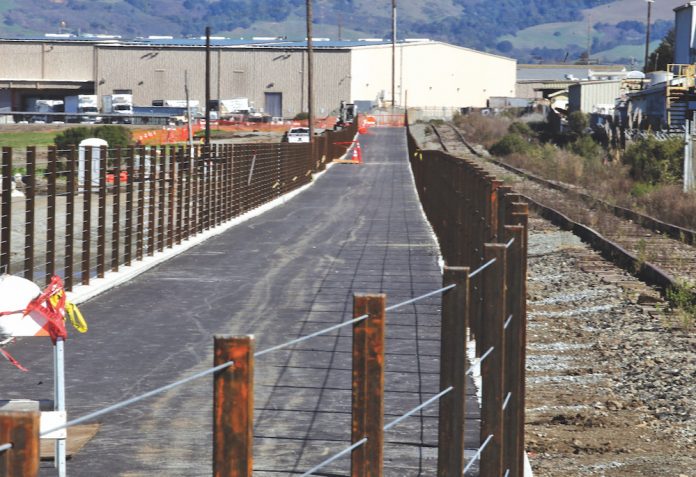SANTA CRUZ COUNTY—The Santa Cruz County Regional Transportation Commission (RTC) on Thursday took a significant step in plans to create a passenger rail system from Santa Cruz to Pajaro, which advocates are billing as a major milestone in a years-long effort.
The approval of the Transit Corridor Alternatives Analysis & Rail Network Integration Study—a 300-page report that lists electric rails as the “preferred local alternative,” means that the county can move forward with plans to build a passenger rail service, with a trail running alongside it, said Mark Mesiti-Miller, a member of Friends of the Rail Trail (FORT). That group has been working to make a bike and pedestrian path next to the county’s rail line since 2002.
“We’re moving forward,” Mesiti-Miller said. “This is great news.”
The 9-3 vote fell along somewhat predictable lines, with commissioners Manu Koenig, Jacques Bertrand and Randy Johnson dissenting.
Koenig, who formerly served as executive director of Greenway Santa Cruz, made a trail-only option a mainstay of his recent successful bid to unseat John Leopold for a seat on the Santa Cruz County Board of Supervisors.
Next, the RTC will create a business plan—expected in April—which will be an analysis of the costs of the project and how it would be funded.
The commissioners voted down an amendment by Commissioner Patrick Mulhearn that would have included an option to ask county voters to approve a tax to help fund the project.
“By my calculations we’re short by $12 to $15 million dollars to pay for this,” Mulhearn said.
Other commissioners, however, said it is too early in the process to be considering specific funding mechanisms.
Commissioner Bertrand agreed, and asked the commission to table the vote until the business plan was available.
“I cannot support approving the staff recommendation without a clear understanding of what the costs are,” he said.
That amendment was also voted down.
Advocates say the rail-trail project would provide an economical way to get to work reduce traffic, and take a chunk out of greenhouse gas emissions caused by personal vehicles.
Mesiti-Miller said the approval Thursday puts the county in line with many communities around the world that are increasingly moving away from passenger vehicles and toward public transportation.
“Rail will happen,” he said. “Exactly when is a little fuzzy, but I would remind people that public transit is essentially a civil right. Denying a segment of the population the freedom to move around is denying them opportunity and mobility, and this community will not stand for that.”
But while the vote signals a new chapter in the story of Santa Cruz County’s transportation future, it is by no means the end of the tale. A wide swath of the community opposes the idea of rail service that would one day bisect the county.
Trail Now Executive Director Brian Peoples has said that the 32-mile system of tracks and aging trestles is not equipped to handle the estimated 60 trains per day traveling 45 miles per hour, and that the rail line is not wide enough to safely hold a train and trail.
He points in particular to the giant, aging trestle that towers over the city of Capitola.
Peoples says he was frustrated by the vote, which he contends will further delay a long-awaited trail that could be used by bicycles and pedestrians.
“We want a trail now, and they are holding it hostage with their ideology of a billion dollar train that they will never have,” he said. “And in the meantime we can’t have the trail.”
Peoples says that a cross-county trail would cost in the hundreds of thousands of dollars to construct, a far cry from the millions per mile estimated for the rail-trail.
There are 20 separate segments of trail throughout the county, and each jurisdiction is responsible for theirs. In places, that work has already begun. In Watsonville, a stretch that runs from Lee Road to Ohlone Parkway, is nearing completion.
The trail is slated to be complete by 2030, and the rail line will soon follow, organizers say.
The SCCRTC in 2018 approved a plan to allow Lakeville, Minn.-based Progressive Rail, Inc. to take over the rail-freight operations in South County. The company’s plans at the time included possible passenger service. In 2019, the agency in a rare unanimous vote showed its support for the rail-trail project.
The passenger rail service portion of the project will cost an estimated $325 million. It is largely funded by Measure D, the 2016 half-cent sales tax created to fund countywide transportation projects. In addition, the State Rail Plan identifies $1.5 Billion for projects in the Central Coast area, some of which will be allocated for the project.
The rail-trail will cost $283 million, and will also be funded by Measure D, as well as a mix of state and federal funding.









